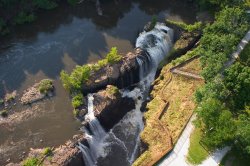The Main Points
- Phosphorus is an important nutrient for aquatic plants in aquatic ecosystems.
- Even small amounts of phosphorus can lead to nuisance weeds and algae blooms.
- Monitoring and measuring phosphorus levels are important for assessing the health of the waterbody.
The Details
Both phosphorus and nitrogen are essential nutrients for the plants and animals that make up the aquatic food web. These two nutrients can exist in a number of different forms but we are usually concerned with ammonia (one nitrogen atom and three hydrogen), nitrates (one nitrogen atom and three oxygen) and ortho-phosphates (one phosphorous atom and four oxygen atoms). Both of these nutrients are water soluble and thus immediately available to aquatic plants and algae.
In most freshwater systems, nitrogen is abundant and phosphorus is in short supply. Fortunately plants do not need a lot of phosphorus. Even a modest increase in phosphorus can, under the right conditions, set off a whole chain of undesirable events including excessive plant growth, unsightly algae blooms, low levels of dissolved oxygen, and even the death of certain fish, invertebrates and other aquatic animals.
Generally speaking, 30 micrograms of phosphorus per liter of lake water is sufficient to set off an algal bloom. Therefore, monitoring phosphorus is challenging because it involves measuring very low concentrations.
There are many sources of phosphorus, both of natural and human origin. These include soil and rocks, wastewater treatment plants, runoff from fertilized lawns and cropland, failing septic systems, runoff from animal manure storage areas, disturbed land areas, drained wetlands, water treatment and commercial cleaning preparations.
The phosphorous cycle begins with the water-soluble form. Because this is immediately useful to plants, we sometimes refer to it as bioavailable phosphate. Aquatic plants take in bioavailable phosphate and convert it to organic phosphorus as it becomes part of their tissues. Animals get the phosphorus and other nutrients they need by eating aquatic plants, other animals, or decomposing plant and animal material.
As plants and animals excrete wastes or die, the organic phosphorus they contain sinks to the bottom, where bacterial decomposition converts it back to bioavailable phosphates. This material dissolves back into the water column and is taken up by plants so the cycle begins again.
